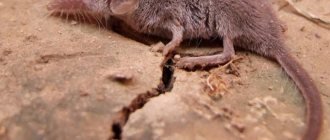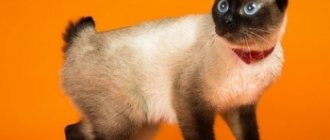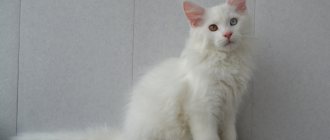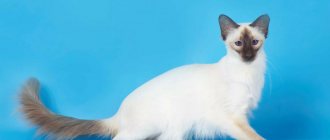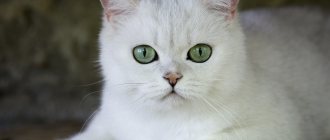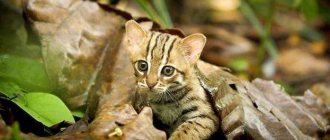History of appearance
Despite the fact that millions of dollars are spent annually on studying felines, there is still no definite answer - when and how did the cat (K) appear in our homes? The approximate date of the appearance of the domestic K, or rather its ancestor - the steppe - is 140 thousand years ago. Being essentially one of the subspecies of the wild forest cat, the steppe, spotted or African K still lives in the steppe, desert and mountainous regions of Africa, Asia, Transcaucasia, Kazakhstan, and India. Artificially bred cat breeds have the genes of their ancestors - wild K. The word “cat” itself comes from Latin. Derived from “captus” or “captat” - smart, bringing prey.
Features of character and behavior
The ancestors of the European Shorthair cat are ordinary cats who have struggled for survival for centuries, not always in favorable climatic conditions. This strengthened their character, made them independent and freedom-loving.
The descendants received these characteristics in full, and selection did not destroy them. A proud and independent Celtic cat will communicate exclusively on equal terms and will not tolerate the violation of its rights. However, this does not mean that representatives of this breed are overly harsh. They are friendly and quite peaceful towards people; they simply will not allow themselves to be offended.
The ancestors also passed on hunting instincts to the Celts in full, and a pet of this breed will definitely strive to realize them. You must be prepared for the fact that a predator that is nocturnal in nature will also show itself at home.
Night hunting, sometimes accompanied by stomping and damage to furnishings, is likely to be one of the entertainments of a pet of this breed.
European cats are not known for being “talkative”; their voice can only be heard under some unusual circumstances. The animal can meow to remind you that it is time to feed it.
They tolerate loneliness easily and are quite capable of finding entertainment on their own. They may recognize a biped as the leader of the pack, but most likely they will not tolerate any more quadrupeds on their territory. Having chosen a leader and recognizing his power, the cat will imitate its owner, adopting lifestyle features and even character.
Breeds (P)
There are several dozen cat breeds in the world. How to determine the breed of a cat (PC)? For most of them, the International Federation of K-Lovers - FiFe- has approved a standard describing the ideal exterior. For each breed, the structure of the body, its proportions, size, height and thickness of the paws, length and shape of the tail, and coat are specified in detail. Particular attention is paid to the head - shape, size, bite, location and shape of the ears, eyes - their size, color and shape. The breeds of modern cats are very diverse - the typical classic look, cats with almost no tail, a breed with short legs and many others.
Broccoli in service
The soldiers were happy about the cat, the officers did not object. Those who stayed on night duty especially rejoiced at her: the sociable gray-striped cat brightened up the loneliness of those on duty. Broccoli moved into the barracks. The soldiers - and there are about 400 of them in the barracks - chipped in for her food and for the veterinarian when the cat was sick. However, in the summer of 2013 the situation changed: Broccoli was officially put on payroll in the Swiss army.
Now both cat rations and visits to the veterinarian are paid for by the Swiss Ministry of Defense. And Broccoli has been going to the vet more often lately: she is now 13 years old and suffers from arthrosis. Of course, the soldiers did not stop feeding their pet. And not only soldiers: the cat Broccoli has her own page on Facebook, and almost 3,000 feline admirers quickly added her as friends. After this, Broccoli quickly became a celebrity.
Swiss media often call the animal a “military cat.” Many people consider it their duty to send Broccoli something tasty. The unit's officers even believe that the cat is a bit fed up. “Well, she definitely won’t eat broccoli now,” one of them said in an interview with the Swiss newspaper Tierwelt (Animal World). However, the “brigadier general” did not gain weight at all. After all, the cat has enough worries: she looks after a territory of 6 hectares! After being put on pay, Broccoli's freedom of movement also improved: cat doors were installed in the barracks.
What breeds of cats are there?
Let's look at the most famous cat breeds. Let’s immediately make a reservation that we will give recommendations on choosing an animal for the family very carefully, simply describing its features. Cat breeds can be divided according to different characteristics - coat length, color, size:
- hairless - Canadian, Mexican;
- shorthaired - Russian, European, British, European, Abyssinian, Siamese, Oriental, exotic, etc.;
- semi-longhaired - Turkish, Burmese, Norwegian, raccoon, Maine, Somali, etc.;
- long-haired - Kumer, Balinese, Persian, Peking, etc.
Siamese cat
One of the most popular oriental cat varieties is the Siamese. Supposedly this breed originated in Asia and has a thin, muscular and flexible body. The eyes are almond-shaped, slightly slanted, and the coat is shiny and short. They only have one color and it’s called color point.
Siamese cats are quite sociable and love to be the center of attention. If they are not given due attention, the cat will begin to scream and moan heart-rendingly. They are considered quite smart. Siamese cats love to be petted and become very attached to only one owner.
A cat breed that hardly sheds: features
Yes, they are hairless cats.
Canadian sphinxes
They still have fur, despite the erroneous opinion of amateurs. Only it is very, very small, reminiscent of suede. It is clearly preserved on the nose, the back of the ears, and maybe on the ends of the paws and tail. It appeared as a result of a mutation fixed over several generations. By nature, these home Ks are very sociable. This is a cat - a companion. They also have an extraordinary mind and good disposition. If you want to have an active, intelligent, inquisitive cat, then the Canadian Sphynx is the most suitable cat breed for this.
Don Sphynx
An amazingly graceful creature, surrounded, like all unusual cat breeds, by a bunch of myths. They say that sphinxes relieve muscle pain, treat nervous disorders and diseases of the musculoskeletal system. This is a relatively new breed of cat, having appeared since 1987. in Rostov-on-Don. The Don Sphynx is a cat-dog in appearance. A large, muscular body, a long tail and paws with toes similar to human ones, absolutely gorgeous slanted almond-shaped eyes - it’s quite easy to determine the breed of a cat. These are calm cat breeds with an independent, sometimes a little lazy character. Easy to train, they will not run like crazy to obey your command.
Peterbald, or St. Petersburg Sphinx
Graceful, with a long, muscular neck and a proud profile, the Peterbald cat is very talkative, affectionate and quick-witted. However, he will not allow himself to be offended: Peterbalds are touchy and capricious. Peterbald kittens can have coats that vary in location, length, coarseness and color. In adult animals, residual fur may remain in some places. All these nuances are spelled out in the P standard.
Ukrainian Levkoy
This lop-eared hairless K first appeared in January 2004. as a result of crossing the Scottish Fold and the Don Sphynx. Levkoys may have velor fluff all over their body - the so-called. brush reaching 3 cm. The skin is very elastic, forming folds in the groin, armpits, around the eyes, between the ears, and on the neck. Levkoys are the most affectionate and loving cat breeds. They love to sit on their hands. If you are ready to see the Tail as an equal member of the family, controlling you, monitoring all your actions, then this is your breed. In fairness, it must be said that, despite their extreme curiosity, lefties are delicate and intelligent. They are not picky or vindictive, and quickly find contact with all residents of the apartment.
Elf
This breed, with its ears curled back, has the genes of the American Curl and Sphynx. There may be some fur on the paws and tail, and the skin has many folds. An interesting feature of this breed is the absence of eyebrows and mustaches. They can be represented by single thin hairs. Elves are very friendly and kind. And most importantly, they are very patient. If you are thinking about what breed of cats to choose for a child, especially a small one, then elves are beyond competition. Natural intelligence and delicacy allow these fabulous little ears to gently communicate with babies and play with them without the use of claws and teeth.
Bambino
These funny Ks with short legs were the result of crossing Munchkins and Canadian Sphynxes. Even adult animals resemble kittens - they are so funny and touching. Playful, spontaneous, cats with short legs are easy to train. They get along comfortably with children and various animals, and are contactable with all family members. At the same time, they can choose one person as their main and favorite. This cat with short legs has a strong body and excellent health. They do not have spinal problems like short-legged dogs.
List of royal breeds
Not every cat can be classified as royal. Obviously, such a title had to be earned by some outstanding qualities.
Iranian Persians and Turkish Angora
It was not for nothing that two legendary breeds of royal cats came together. In ancient times, they were considered different branches of the same species, and only in the middle of the 17th century were they separated. The characteristic features of the Iranian breed include:
- long hair (up to 12 cm);
- flattened, snub-nosed muzzle;
- these cats do not survive in street conditions without the care of their owner.
Description of the breed. A medium or large cat, squat, with low paws. The chest is developed, the shoulders are massive. The head is very wide, rounded, with a convex forehead, a small snub nose and full cheeks. The ears are rounded at the tips, with internal hair. The coat is long and thick, especially around the collar, chest and shoulders.
The Turkish Angora belongs to a completely different ancient formation of cats. The history of this cat breed began in the territory of modern Turkey. After the animals migrated to Egypt, they had a mutation in the locus responsible for the length of their fur, as a result of which the angora acquired a fluffy and soft coat. The classic color for an Angora cat is white.
Persians and Angoras lived in all the palaces and were considered a gift worthy of kings. These cats left behind numerous offspring. It is possible that even today the blood of those royal pets flows in the veins of some four-legged pets.
Description of the breed. A medium-sized cat with a small pointed wedge-shaped head, high ears and a long neck. The body is flexible, mobile, on high legs with rounded paws. The tail is shaped like an ostrich feather with rich, crumbly hair. The character is kind and inquisitive. The cat demonstrates activity, loves to play and does not strive for loneliness. Has a high level of learning ability.
Asherah
With the advent of the new century, cats with an unusual appearance or some other properties began to be called royal. In addition, breeders began to actively experiment with species, combining the characteristics of certain breeds in mestizos and hybrids.
Among these animals, the Ashera stands out - a cross between a wild and domestic cat. It is notable for two things: its ancestors and the truly royal scam that was associated with this unique animal.
According to the breeder, several parent species took part in the development of the new hybrid:
- from the wildlife side they took a serval - a predatory African cat;
- the domestic line was represented by the Bengal breed, whose ancestors also had the blood of wild and ordinary cats.
The breeders' plans were to obtain a natural spotted coat color and an easy-going character. In 2007, experts were presented with an Asher, the weight of an adult individual reached 15 kg, and the body length was about a meter.
The initial cost of kittens of the new breed turned out to be truly royal - sales started in the range of 22-27 thousand dollars. But it soon became clear that the newly created Asherah is nothing more than Savannah, known since 1986. Experts conducted a DNA test, based on which the new royal breed was not recognized by international felinological unions.
Generations of hybrids in the F1-F4 category are recommended for aviary placement. All cats in this group are sterile, and girls are bred with domestic pets (for example, Burmese breed). Savannahs F5-F7 inherit all the positive qualities from ordinary cats. They are active, playful, attached to people and easily adapt to apartment living.
Description of the Savannah breed. Large 15 kg cat. Height at the withers is up to 60 cm. The body is elongated, the legs are long, with beautiful oval paws. The ears are rounded and set wide apart. The coat is thick, spotted, short.
Siamese royal cat
As a result of the Burmese-Siamese wars, which lasted for 3 centuries, Thai royal cats found their way outside Siam for the first time. But the first documented “exit” of Siamese dates back to 1878, when the American consul in Bangkok sent an unusual-looking kitten to the 19th US President Rutherford Hayes. And only 6 years later, in 1886, a couple of aliens from Asia came to Britain. Later, a small group of 11 animals formed in England, which felinologists designated as the “royal cat of Siam.” It is believed that all modern Thai representatives of the old island empire are their descendants.
Description of the breed. Medium size, elongated body and wedge-shaped head. The profile is smoothed, the eyes are set obliquely, the ears are high and pointed at the ends. The cat's coat is short, adjacent to the body, and lacks undercoat. A long, whip-like tail, thin from the base and pointed at the end. The standard color is acromelanic color point.
Analostanka
The most amazing breed of all listed. She is not in any professional felinological reference book, and the only mention is in the short story “The Royal Analostanka”, written by Ernest Seton-Thompson. The whole plot boils down to how an ordinary slum cat was given the loud name “Royal Analostanka” after the name of the fictional island from which she came from. A century and a half has passed since then, but the legend about the unusual animal continues to live and even acquires more details.
The author presents the character as a large domestic animal with thick semi-long hair and a beautiful marbled color. By nature, analostans are independent, independent, successful in hunting, active and playful. Here is an approximate portrait of a cat, which can equally belong to both the domestic and semi-wild populations.
Shorthair cat breeds
There are many different breeds of such cats in the world. They are all very beautiful, smart, affectionate. The list of advantages is almost endless. How to find out the cat breed that is right for you? Read our article, think. Study the characteristics of the animal and consider your capabilities. And most importantly, listen to your heart.
The most popular cat breeds with short hair.
Siamese
These kisuls cannot be confused with other representatives of the kitten tribe. Miniature, graceful, with a wedge-shaped long head. Plus a very special fur color and blue eyes. Siamese are very smart and talkative. Add here absolute devotion to the owner, accuracy, independence and self-sufficiency, and it becomes clear that these are aristocrats from ears to tip of tail. Siamese cats love to play, jump, and communicate with people. But they will be jealous of other pets. Therefore, if you decide to adopt a Siamese into your family, be prepared for the fact that these representatives of the cat will take leading positions in the family hierarchy and this will need to be taken into account. In return you will receive love, affection and a lot of positive emotions. Don't listen to nonsense about evil Siamese monsters attacking their owners. This is simply not true.
Thai
A very special variety, despite the erroneous opinion that they are confused with Siamese. The difference is in a stronger and more muscular body, a rounded head, and lower legs. Thais are one of the most intelligent representatives of kittens. Intelligence and natural intelligence, curiosity, perseverance, enviable persistence in achieving goals, accuracy, tact - the advantages of these Ks cannot be listed. Thais are very attached to their owner and love to talk to him. For a child, you will not find a better friend, protector, or playmate than a Thai. This is the kindest, most affectionate cat breed.
Burmese
A very beautiful breed of cat with a bright personality. Ideal proportions, strong build, silky coat with an unusual sheen, without undercoat, mesmerizing amber eyes - everything about them is amazing. Burmese are intellectuals, they easily get along with families and do not conflict with other living creatures. But at the same time they remain leaders. Energetically strong, Burmese are strong-willed, participate in all household chores, love to be the center of attention, play wonderfully with small children, who are forgiven for careless movements, excessive curiosity, even attempts to get their fingers in the eyes. In fact, the Burmese is the calmest and most affectionate cat breed.
Japanese Bobtail, a breed of cat without a tail
The Japanese Bobtail is the oldest representative of the cat breed without a tail. Their body is of medium size, moderately well-fed. Long, slender limbs, slanted eyes, and most importantly, a short ponytail. It can be twisted, straight, curved or rigid. And this is the special charm of the bobtail. By nature, a cat without a tail is very unpretentious. Loves to communicate and talk with the owner. Bobtails are easy to train and you won’t get bored with him. If there are already other pets in the family, the bobtail will make friends with them and involve them in its games. You need to keep an eye on such an active pet, otherwise you risk becoming victims of his hyperactive behavior.
Snow shu
They appeared as a result of crossing the American Shorthair and Siamese K. The name of the breeds often 100% characterizes the appearance of the animal. So, snowshoe translated means “snow shoe”. These beauties have snow-white shoes, boots and the same contrasting markings on the face and chest. Irresistible cornflower blue eyes, a proportional body with developed muscles, shiny fur, a neat head - they are perfection itself! They have a very friendly, angelic disposition. Snowshoes are attached to their owner and need attention and communication. This tame K is good with children. Snowshoes love to choose high places to play and show great ingenuity in achieving heights. A special feature of the Snow Shoe is its love for water. On occasion, they will not refuse to swim in the bath and play there.
British Shorthair
One of the oldest officially registered branches. They appeared in the process of crossing cats of the ordinary domestic English and Persian breeds. These are strong and large animals with a wide chest and a large head. The legs are short, the tail is medium length, thick. The British make a very solid impression. And for good reason! Plush, flexible, kind, trainable - the British dog has a lot of advantages. Due to his personality traits, the British cat is ideal for busy people, as he requires minimal care, easily tolerates loneliness, and finds something to do for himself. This very friendly creature is capable of making friends with a dog and is family oriented. Even other people's kittens will be licked, fed and warmed. It is important to note that the British are in dire need of outdoor games, as they tend to be overweight. For the same reason, they should not be overfed.
Devon Rex
These interesting eared animals have English roots. The great-great-grandmother, the ancestor of the Devon Rex, lived in Devonshire in 1960. In fact, they began to be called that way - according to their place of origin. The original appearance and no less original character of the Devons has given rise to many fans of this breed of domestic cats. Huge ears that look like butterfly wings, almond-shaped eyes, and, most importantly, curly fur - such a handsome man will undoubtedly win any heart.
Meanwhile, they are monogamous: they choose one owner for themselves and surround him with their attention and love. If there are already animals in the house, then, having met them, the Devon kitten can get along. And as an adult, a Devon is unlikely to warmly accept another four-legged pet. Very physically developed, Devons are very jumping and agile. They also have a very pleasant voice.
Toyger
This large cat breed is brindle in color. Adults weigh about 10 kg. Appearance – tiger stripes, dense fur, very expressive eyes – is very reminiscent of a formidable predator. But their temperament is very good, flexible; toygers love to play with their owner. They will gladly agree to go for a walk and will not be afraid of anyone, even a random dog. The Toyger is the most beautiful of the recently bred breeds.
Subtleties of care
Special attention should be paid to the development of Havana kittens. This oriental breed grows quickly. Kids are very energetic and curious, they always strive to steal something.
At the same time, they will hide it so that it can never be found again. This activity increases the risk of injury, so kittens need safe living conditions.
An older pet remains just as playful, but more cautious. He will curiously explore the room in search of experiments and conquer heights.
For a cat of this breed, it is best to purchase more toys. A playground would be just the perfect solution. The animal will always be busy.
The Havana cat does not require special care. It is not recommended to carry out water procedures more than once every couple of months. The cat's fine fur will dry out, become brittle and lose its shine. After bathing your pet, you need to wipe it dry.
Note!
Singapore cat: character, photo, price, breed description, reviews, how to buy, how to choose, maintenance, care and owner reviews
Scottish Straight: cat photo, kitten prices, breed description, character, reviews, maintenance and care, nutrition + interesting facts
Chausie - overview of the breed, character and breeding characteristics. Price for a kitten and tips for choosing a purebred cat (115 photos)
The Havana is a short-haired breed, so it does not need to be brushed often. A few times a month is enough. It is better to comb out with a rubber glove and use an antistatic agent.
Maintain hygiene of the animal's eyes and ears. Wipe them twice a month with a cloth soaked in warm water.
The Havana breed does not have genetic diseases. A proper diet and timely vaccinations will ensure your pet a healthy and happy life.
The most famous breeds of semi-longhair cats
Maine Coon is a breed of cat similar to a lynx.
The largest cat. Resembling a lynx with its ear tufts, the Maine Coon cat can weigh up to 15 kg. Similar to a lynx, Maine Coons can have different colors - in color and uniformity - there are only six of them: black, white, blue, tortoiseshell, cream, red marble. Even ginger cats fit into the standard of this breed. The correct name for this color is red marble. Maine Coons are very hardy and strong. Along with this, they are distinguished by their flexible disposition and extraordinary intelligence.
Maine Coons are talkative cats, they always have something to say to their owner, they comment on everything. Excellent swimmers, Maine Coons are not afraid of water and take showers with pleasure. Adult cats behave like children - they are very playful. You won't find a better playmate or a better nanny for your baby. Adopt a pair of these lynx-like felines into your family and you won’t regret it!
Maine Coons are also excellent hunters. Therefore, they will not be able to make friends with rats - hamsters. But this lynx-like breed of domestic cat can kill mice very quickly.
Sacred Burma
If there is a rating “The most beautiful cat breeds”, then the Burmese will take a leading place in it. The history of its appearance goes back to the deep past and is associated with Buddhist monks. What is true in this legend is not the main thing. The main thing is the existence of an absolutely gorgeous breed. Strong skeleton, round head, medium length coat, very silky. A very characteristic color - a mask on the face and white, clearly defined gloves and boots on the paws - creates a charming image.
The Burmese have a very intelligent character; they will not allow themselves to misbehave and loudly conflict. Innate delicacy and accuracy - these are very well-mannered animals. It will give you great pleasure to communicate with them.
Turkish Angora is a representative of the white cat breed
The classic Turkish Angora is a white cat. And it is this color that remains the priority. Angoras are proportionally built, very graceful, and jumping. They can have different eye colors: green and blue. Unfortunately, such animals have hearing problems - they are deaf on the side of the blue eye. The undoubted decoration is the fluffy tail, reminiscent of an ostrich feather.
The coat does not require complex care, but when the angora sheds, combing is required. The rest of the time, it is enough to treat the fur with dry shampoo, since these representatives of the white cat breed do not welcome water procedures. These are cheerful, but slightly phlegmatic creatures, they are easy to train, have an independent disposition, and are very playful. They love children and get along well with them. In a family, the Angora will be a devoted friend and companion.
Origin story
European shorthair cats are the result of breeding by felinologists in Europe. They came from ordinary domestic cats that inhabited the continent for centuries. Basically, at the beginning of the 20th century, the selection of this breed was carried out by specialists from Germany, Great Britain and France. British felinologists became more interested in individuals that had a squat, large body with a large round head. This interest eventually resulted in the breed that is today well recognized and known as the British Shorthair.
The French were also interested in this appearance; they produced chartreuses that were very reminiscent of the British. In the United States, based on the European Shorthair, they developed their own larger breed, called the American Shorthair.
The breed, which today is called the European Shorthair, was bred by specialists from the Scandinavian countries. The first cat was registered in the mid-20th century as the Swedish Shorthair.
Initially, such cats were classified as British; at championships and exhibitions, the standards of this breed were used to make decisions (in those days, cats that are now known as British and were called European Shorthairs). Finally, the issue of breed separation was resolved.
This happened in 1982, when one of the largest and most influential European cat associations, FIFe, introduced different standards for the British and Europeans.
Long-haired or fluffy breeds of domestic cats
Persian
These fluffy cats are one of the most popular. And this is well deserved: in addition to their unearthly beauty, Persians have a wonderful character. Very domestic, perhaps the calmest of cats, they will love all members of the family, or they can choose their favorite owner, especially revered and respected. Regardless of this, they get along well with children and behave very correctly in games. Considered “couch” cats, Persians are nevertheless active - they enthusiastically hunt for small game that accidentally flies in - butterflies, flies.
An external, obvious sign of the Persians is the shape of the nose - small and snub-nosed, quite wide. May be upturned. This is a breed of cat with short legs and quite muscular. Quite large, up to 7 kg, Persians seem even larger due to their thick fur. The fur is very soft, requiring regular brushing, grooming and bathing. Sometimes there is a need for a haircut. This nuance must be taken into account when choosing a feline family member.
Norwegian forest
Descendants of wild Norwegian forest cats, these representatives of the cat tribe are the official K of the country. These are large individuals with a strong and flexible body. Fluffy and long tail, tufted ears, large eyes. But, of course, the main thing is the waterproof double-layer wool. The outer layer is long, shiny and soft. And the inner one is very dense, with oily, water-repellent hairs. Despite its wild origins, the Norwegian Forest Dog is very friendly to people and is comfortable in the home.
Having an independent cat disposition, she will be a devoted friend. The Norwegian Forest Dog is loyal, even friendly, to strangers who come into the house - he can come to his knees and let him pet him. But you need to communicate with them politely, without familiarity, otherwise you risk recognizing the sharpness of the teeth and claws of this beauty.
Neva Masquerade
The most common type of Neva Masquerade is the Siberian K with seal point color. Of particular interest are the gray cat (the same breed) - the so-called. “darkened” color options. And there are also Neva ones with white paws - also very interesting and beautiful. Powerful build, large paws of medium length, tufts of hair between the toes, blue eyes - the whole appearance of the Nevaks emphasizes aristocracy. The two-layer coat with an internal water-repellent undercoat warms the owner in cold weather. Excellently physically developed, Nevaks are very jumping and playful.
These fluffies have a very sociable disposition, they are tactful, loyal, not vindictive, but wary of strangers. They respond with pleasure to their name and remember it easily. They are good friends with children and other animals. Good family men - cats actively participate in raising offspring. The list listing good cat breeds begins with the Neva Masquerade.
Munchkin longhair
The Longhaired Munchkin is a variant of the regular Munchkin. This breed of cats is also called - cats with sad eyes, K-dachshunds, kangaroo K. Having short legs, munchkins easily sit on their hind legs and lean on their tail. Munchkins have a sociable character; they love to walk on a harness and play with children. They are absolutely not aggressive, they are full of love and tenderness. For families with children, this is the most suitable feline.
Royal cat breeds in palaces and in the destinies of monarchs
The modern European fashion for cats started in Great Britain, which in the mid-19th century became the center of migration of all exotic breeds from the East and Asia. Sea trading ships came here, warriors returned, and cats came with them.
The world's first official review took place in England (1871), for which the Crystal Palace of London, built a decade earlier to host the World Exhibition, was allocated. Reports about the cat inspection the next day replaced all other high society news on the front pages of newspapers. Six months later, another exhibition took place, and later they began to be held regularly. We can consider that from this moment the era of European royal breeds began.
History knows many examples of famous royal cats that lived in the palaces of monarchs.
During the French Revolution, Marie Antoinette planned to escape from Paris to America. At the same time, she ordered all the luggage to be sent to the ship in advance, among which were 6 beloved royal cats of the Turkish Angora breed. The plot failed, the lives of the French monarchs ended tragically, but the cats successfully survived the journey overseas and became the ancestors of the large American Maine Coons.
Another historical figure, Cardinal Richelieu, was a passionate cat lover. At least 12 animals lived in his palace, which were brought to the influential minister as gifts by ambassadors of foreign powers. Louis XIV will continue the tradition. During his reign, part of the royal apartments was given “at the disposal” of furry pets.
But Emperor Napoleon Bonaparte was wary of cats. There is a legend that on the eve of the Battle of Waterloo he saw a jet-black cat in a dream and was so demoralized by this event that he lost the battle.
In ancient Siam, cats allegedly even guarded royal palaces. Later, the animals came to Europe, but even here they became famous for their complex character with attacks of aggression and rapid excitability.
From medieval China, tailless bobtails were brought to Japan, which the emperor and the nobility liked. Later, an invasion of rodents began on the islands, and the cats turned out to be excellent hunters. They saved food supplies, which prevented famine. The Japanese especially appreciated the participation of cats in the preservation of cultural values - voracious mice almost destroyed ancient books that were written on rice paper. Since then, this breed of royal cats has been highly respected in the Land of the Rising Sun.
Photo
Burmese cat
The Burmese cat breed was officially registered in the early 50s. last century, in France. After 10 years, kittens of this breed fell into the hands of an American breeder, thanks to whom Burmese cats were recognized in the States.
Burmese cats have soft fur and unusual yellow eyes. Cats do not require careful care. Eye color as a result of crossing with Siamese can acquire a green or blue tint. Blue eye color is not possible in a purebred Burmese.
Burmese cats, like Siamese cats, are very sociable, but their voice is much more pleasant. They have love, affection and trust for their owners.
How to choose a “comfortable nickname” for a cat
A cat receives a name to which it must respond, not only after the clink of a spoon and bowl. It’s quite simple to choose a name that your pet will always hear, but you need to resort to tricks and use the knowledge of cat physiology:
- The brains of little hunters are tuned to catch any sounds that rodents make. The squeaking and “wooshing” of a mouse are incomplete sounds, but overtones that are partially reproduced in human speech when pronouncing the letters “s”, “z” and “ts”.
- Cats only meow when communicating with people. The letter “m” and its combination with “ya” and “u” acts as a means of feedback communication.
- Pets remember a lot of long words, however, the most acute reaction is observed to short and meaningful ones - “Eat”, “Come to me”, “Clever girl”. The optimal length of a nickname is no more than 2 syllables and it is easier for you, and the cat will hear and perceive the name, even if it is busy with something.
- The sounds produced when pronouncing the letters “zh”, “ch”, “sh”, “sch” remind the cat of an opponent’s warning signal before a conflict or fight. Of course, the pet will react to the name, however, associatively, the cat will be wary, afraid, or preparing to attack.
